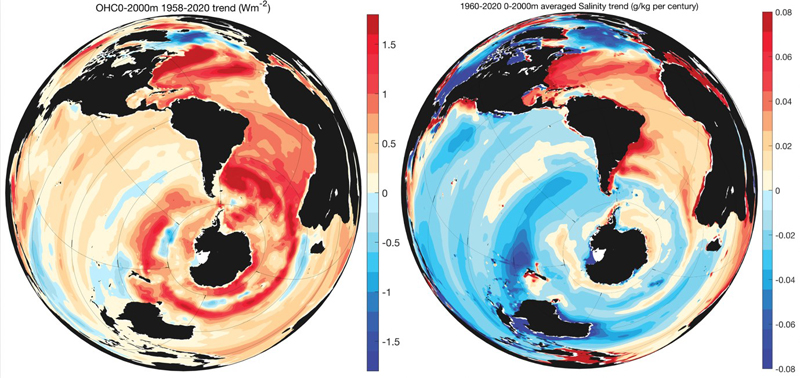Even if society is able to slow all greenhouse gas emissions and get to "net zero" by mid-century as targeted by nations of the world in the UN Paris Agreement, there is a lag built into the climate system primarily as a result of ocean thermal inertia. This means slow emerging changes such as deep ocean warming and sea-level rise will continue very long afterward.
Climate scientists argue in a new review paper that this means climate actions need to be established at multiple time scales. The paper has recently been published in
Atmospheric and Oceanic Science Letters.
The global ocean, which covers some 70 percent of the Earth's surface, is slower to absorb and release heat than land. The large mass and heat capacity also means the ocean is much more capable of storing heat than air or land, and the ocean is hence the most important controlling component of the Earth's climate.
This "ocean thermal inertia" offers both good news and bad news with respect to climate change. It means that the planet is not heating up as fast as it would without an ocean. But it also means that even once we halt greenhouse gas emissions by about 2050 to 2060, as laid out in the United Nations Paris Agreement, the climate system will still continue to change for a considerable amount of time afterward.
The ocean will keep on warming as heat is transported downwards into deeper ocean waters, and the climate system will only re-stabilize when that deep ocean stops warming and the Earth reaches an equilibrium between incoming and outgoing heat.
"This process means that while surface warming may stabilize at about 1.5-2℃ when global emissions reach net-zero emissions, sub-surface ocean warming will continue for at least hundreds of years, yet we normally only talk about climate action on the scale of a few decades to the end of the century at the most," said lead-author, Prof. John Abraham, a mechanical engineering researcher with the University of St. Thomas in Minnesota. "That needs to change."
Therefore, a system of scientific ocean monitoring with that time-scale in mind needs to be developed. Besides subsurface temperature and sea level, the tracking of ocean climate trends such as pH, sea ice, ocean surface heat flux, currents, salinity, carbon, will require long-duration consistent and calibrated measurements. Compared with temperature, these essential climate variables are currently much less observed.
Observed upper 2000 m ocean heat content and ocean salinity trends in the past half century. Data from IAP ocean dataset (http://www.ocean.iap.ac.cn/). (Image by CHENG Lijing)
"Changes to the ocean will also continue to impact extreme weather over these longer periods, as well as sea-level rise," said Prof. CHENG Lijing from the Institute of Atmospheric Physics, Chinese Academy of Sciences. "And infiltration of sea water into fresh water supplies can affect coastal food supplies, aquifers, and local economies. Other impacts that are connected to ocean warming and so need to be considered for the very long term include more damaging storm surges, coastal erosion, marine heatwaves, ocean acidification, and marine oxygen depletion."
"Clearly, this later group of measures will take a much longer time to implement but will also provide much longer lasting benefits," said Pennsylvania State University climatologist Michael E Mann, another co-author of the paper. "Multi-scale adaptation practices like this should be considered throughout the globe."
The researchers also suggest that societies need to begin to consider ensuring they are resilient in the face of "high impact, low probability" events (an unlikely event that would have significant consequences if it happens).





